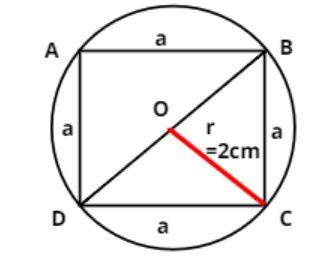
A square is inscribed in a circle of radius 2 cm. Side of the square in cm is:
$\left( A \right)\sqrt 2 $
$\left( B \right)2\sqrt 2 $
$\left( C \right)4\sqrt 2 $
$\left( D \right)2\sqrt 3 $
Answer
587.7k+ views
Hint – In this particular type of question first of all draw the problem diagrammatically representation and mark all the points it will give us a clear picture of what we have to find out, later on in the solution use the concept that the diameter of the circle is same as the diagonal of the square and also use the Pythagoras’ theorem so use these concepts to reach the solution of the question.
Complete step-by-step answer:

The pictorial representation of the square inscribed in the circle is shown above in the diagram.
Let O be the center of the circle and the diameter of the circle is also the diagonal of the square as shown in the figure.
Let ABCD be the square.
Diagonal of the square BD = diameter of the circle (see figure).
Now the radius of the circle is given (i.e. r = 2cm)
As we know that the diameter (D) of the circle is twice the radius of the circle so we have,
Therefore, D =2r = 2(2) = 4 cm.
Therefore, BD = 4 cm.
Let the side of the square be a cm as shown in the figure.
Therefore, AB = BC = CD = DA = a cm.
Now apply the Pythagoras’ theorem in the triangle BDC we have,
$ \Rightarrow {\left( {{\text{Hypotenuse}}} \right)^2} = {\left( {{\text{perpendicular}}} \right)^2} + {\left( {{\text{base}}} \right)^2}$..................... (1)
Let perpendicular = BC, base = CD and hypotenuse = BD
Now from equation (1) we have,
$ \Rightarrow {\left( {{\text{BD}}} \right)^2} = {\left( {{\text{BC}}} \right)^2} + {\left( {{\text{CD}}} \right)^2}$
Now substitute the value in the above equation we have,
$ \Rightarrow {\left( {\text{4}} \right)^2} = {\left( {\text{a}} \right)^2} + {\left( {\text{a}} \right)^2}$
$ \Rightarrow 2{a^2} = 16$
Divide by 2 throughout we have,
$ \Rightarrow {a^2} = 8$
Now take square root on both sides we have,
$ \Rightarrow a = \sqrt 8 = 2\sqrt 2 $ cm.
So this is the required side of the square.
Hence option (B) is the correct answer.
Note – Whenever we face such types of questions the key concept we have to remember is that in any right angle triangle the square of the hypotenuse is the sum of the square of the perpendicular and the square of the base (i.e. Pythagoras theorem), so first calculate the hypotenuse of the triangle (I.e. the diagonal of the square or the diameter of the square) as above and then assume any variable be the side of the square then apply Pythagoras theorem according to above written definition and simplify we will get the required answer.
Complete step-by-step answer:

The pictorial representation of the square inscribed in the circle is shown above in the diagram.
Let O be the center of the circle and the diameter of the circle is also the diagonal of the square as shown in the figure.
Let ABCD be the square.
Diagonal of the square BD = diameter of the circle (see figure).
Now the radius of the circle is given (i.e. r = 2cm)
As we know that the diameter (D) of the circle is twice the radius of the circle so we have,
Therefore, D =2r = 2(2) = 4 cm.
Therefore, BD = 4 cm.
Let the side of the square be a cm as shown in the figure.
Therefore, AB = BC = CD = DA = a cm.
Now apply the Pythagoras’ theorem in the triangle BDC we have,
$ \Rightarrow {\left( {{\text{Hypotenuse}}} \right)^2} = {\left( {{\text{perpendicular}}} \right)^2} + {\left( {{\text{base}}} \right)^2}$..................... (1)
Let perpendicular = BC, base = CD and hypotenuse = BD
Now from equation (1) we have,
$ \Rightarrow {\left( {{\text{BD}}} \right)^2} = {\left( {{\text{BC}}} \right)^2} + {\left( {{\text{CD}}} \right)^2}$
Now substitute the value in the above equation we have,
$ \Rightarrow {\left( {\text{4}} \right)^2} = {\left( {\text{a}} \right)^2} + {\left( {\text{a}} \right)^2}$
$ \Rightarrow 2{a^2} = 16$
Divide by 2 throughout we have,
$ \Rightarrow {a^2} = 8$
Now take square root on both sides we have,
$ \Rightarrow a = \sqrt 8 = 2\sqrt 2 $ cm.
So this is the required side of the square.
Hence option (B) is the correct answer.
Note – Whenever we face such types of questions the key concept we have to remember is that in any right angle triangle the square of the hypotenuse is the sum of the square of the perpendicular and the square of the base (i.e. Pythagoras theorem), so first calculate the hypotenuse of the triangle (I.e. the diagonal of the square or the diameter of the square) as above and then assume any variable be the side of the square then apply Pythagoras theorem according to above written definition and simplify we will get the required answer.
Recently Updated Pages
Master Class 10 General Knowledge: Engaging Questions & Answers for Success

Master Class 10 Computer Science: Engaging Questions & Answers for Success

Master Class 10 English: Engaging Questions & Answers for Success

Master Class 10 Social Science: Engaging Questions & Answers for Success

Master Class 10 Maths: Engaging Questions & Answers for Success

Master Class 10 Science: Engaging Questions & Answers for Success

Trending doubts
The shortest day of the year in India

Why is there a time difference of about 5 hours between class 10 social science CBSE

Write a letter to the principal requesting him to grant class 10 english CBSE

What is the median of the first 10 natural numbers class 10 maths CBSE

The Equation xxx + 2 is Satisfied when x is Equal to Class 10 Maths

Which of the following does not have a fundamental class 10 physics CBSE




